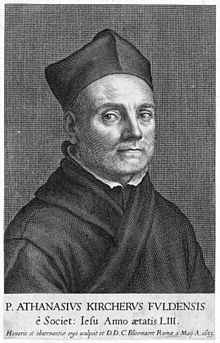Background
He was born on the 2nd of May 1601, at Geisa near Fulda. The youngest of nine children in the family.


He was born on the 2nd of May 1601, at Geisa near Fulda. The youngest of nine children in the family.
He was educated at the Jesuit college of Fulda, and entered upon his noviciate in that order at Mainz in 1618.
He became professor of philosophy, mathematics, and Oriental languages at Wurzburg, whence he was driven (1631) by the troubles of the Thirty Years' War to Avignon. Through the influence of Cardinal Barberini he next (1635) settled in Rome, where for eight years he taught mathematics in the Collegio Romano, but ultimately resigned this appointment to study hieroglyphics and other archaeological subjects.
His voluminous writings in philology, natural history, physics and mathematics often accordingly have a good deal of the historical interest which attaches to pioneering work, however imperfectly performed; otherwise they now take rank as curiosities of literature merely. They include Ars Magnesia (16. 31); Magnes, sive de arte magnetica opus tripartitum (1641); and Magneticum naturae regnum (1667); Prodromus Coptus (1636); Lingua Aegyptiaca restituta (1643); Obeliscus Pamphilius (1650); and Oedipus Aegyptiacus, hoc est universalis doctrinae hieroglyphicae instauratio (1652 - 1655) - works which may claim the merit of having first called attention to Egyptian hieroglyphics; Ars magna lucis et umbrae in mundo (1645 - 1646); Musurgia universalis, sive ars magna consoni et dissoni (1650); Polygraphia, seu artificium linguarum quo cum omnibus mundi populis poterit quis respondere (1663); Mundus subterraneus, quo subterrestris mundi opificium, universae denique naturae diviliae, abditorum effectuum causae demonstrantur (1665 - 1678); China illustrata (1667); Ars magna sciendi (1669); and Latium (1669), a work which may still be consulted with advantage. The Specula Melilensis Encyclica (1638) gives an account of a kind of calculating machine of his invention. The valuable collection of antiquities which he bequeathed to the Collegio Romano has been described by Buonanni (Musaeum Kircherianum, 1709; republished by Battara in 1773).
He published around 40 major works on a very wide variety of subjects, such as Egyptology, geology, and music theory. His importance was twofold: to the results of his own experiments and research he added information gleaned from his correspondence with over 760 scientists, physicians and above all his fellow Jesuits in all parts of the globe.
Kircher was ahead of his time in proposing that the plague was caused by an infectious microorganism and in suggesting effective measures to prevent the spread of the disease.
Kircher was a man of wide and varied learning, but singularly devoid of judgment and critical discernment.
Quotes from others about the person
The scholar, Edward W. Schmidt, referred to Kircher as "the last Renaissance man".
